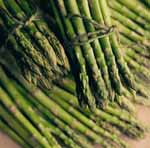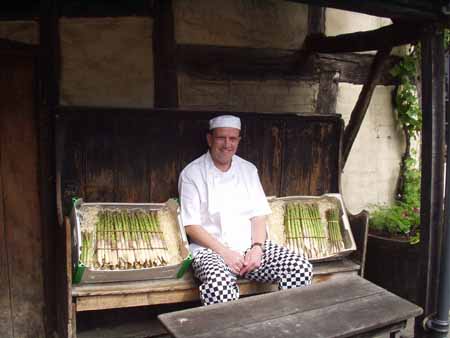Asparagus - the 'food of kings'
Adored by Roman emperors, revered by nutritionists and championed by celebrity chefs – this celebrated vegetable has always caused a stir. Country Life visits the British Asparagus Festival, to find out what all the fuss is about


Nestled in the Cotswold Vale of Evesham, the usually sleepy village of Bretforton is a hive of activity. Crowds of people swarm across the village green – the young, the old, tourists, vegetable growers, morris dancers – everyone in the area is heading to the ancient Fleece Inn, where an accordion player is warming up and Prior's Tipple cider is starting to flow.
It's the first night of the British Asparagus Festival and the peak of the asparagus season, which runs from St George's Day (April 23rd) until Midsummer's Day (June 21). The festivities kick off with an asparagus auction for charity, with bidders vying to win the best bundles of asparagus – or 'rounds of gras' – in the country. Tied with willow strips by local grower Billy Byrd, and containing only the finest fresh spears, the bundles are highly sought-after and the atmosphere is electric. Hotels and restaurants all compete for the cream of the crop; one bundle of 120 stems, known as a 'hundred of gras', goes for £350 – nearly £3 a stem.
Why do people pay so much for a vegetable? 'Asparagus is very difficult to grow,' explains Sam Tippens, a local grower. 'Once you plant the root (the crown) you have to wait three years until you can harvest the first crop. You need time and a lot of patience.'

Nigel Smith, manager of the Fleece Inn, with asparagus bundles ready for the auction
After the initial three year wait, the window for harvesting asparagus is extremely small – just four to six weeks. But, if the conditions are right, it grows very quickly. 'I've seen asparagus growing in front of my eyes,' claims Sam. 'If it's humid and the weather's right, it can shoot up inches in half an hour. You've got to cut it as soon as it's ready, as it can spoil if it stays in the ground for even a week too long.'
It seems like an awful lot of trouble, but Sam says it's worth it for the taste. 'There's nothing quite like fresh asparagus. It's absolutely amazing.' He dismisses the recent habit of drenching asparagus spears in Hollandaise sauce as 'poncey', and prefers his asparagus steamed, with a knob of butter. 'You need to keep it simple to appreciate the flavour,' he explains. 'Less is more with asparagus. It's phenomenal on its own.'
The locals aren't alone in admiring asparagus – it's been hailed as a 'superfood' by the likes of Gillian McKeith because of its excellent nutritional value and powerful antioxidants. Low fat, high fibre, with plenty of folic acid and packed full of vitamins A, C and B6, asparagus is a healthy choice as well as a tasty one. Some even claim it has aphrodisiac properties, though this is not yet proven...
Sign up for the Country Life Newsletter
Exquisite houses, the beauty of Nature, and how to get the most from your life, straight to your inbox.
Asparagus has always been popular. The Roman Emperor Caesar Augustus is said to have feasted upon it and Louis XIV of France loved it so much he had special greenhouses built so he could enjoy it all year round, dubbing it the 'food of kings.’ Perhaps the most memorable literary mention of asparagus is Marcel Proust's reference to the curious after-effects of eating it. He wrote: 'It transforms my chamber pot into a flask of perfume.' Proust's metaphor is somewhat romantic – an 18th century physician to the French royal family was more realistic when he noted that asparagus '…eaten to excess causes filthy and disagreeable smell in the urine.'
A visit to the 650-year old Fleece Inn confirms that asparagus is as popular today as ever. The place is packed with people enjoying traditional asparagus suppers – steamed spears with butter, served with hunks of warm brown bread. The festival is held in the Fleece’s thatched barn and, with morris dancing and the village silver band playing, the celebration remains largely unchanged since the auctions began in the Victorian era. The only difference is the introduction of the new 'Fast gras' menu which includes a hamburger (with asparagus) and a hot dog (with asparagus) as well as asparagus soup served in polystyrene cups. But, after a few barrels of Prior's Tipple, the party is in full swing and the atmosphere is the same as it always has been at this jolly, heart-warming event.
Country Life is unlike any other magazine: the only glossy weekly on the newsstand and the only magazine that has been guest-edited by HRH The King not once, but twice. It is a celebration of modern rural life and all its diverse joys and pleasures — that was first published in Queen Victoria's Diamond Jubilee year. Our eclectic mixture of witty and informative content — from the most up-to-date property news and commentary and a coveted glimpse inside some of the UK's best houses and gardens, to gardening, the arts and interior design, written by experts in their field — still cannot be found in print or online, anywhere else.
-
 Vertigo at Victoria Falls, a sunset surrounded by lions and swimming in the Nile: A journey from Cape Town to Cairo
Vertigo at Victoria Falls, a sunset surrounded by lions and swimming in the Nile: A journey from Cape Town to CairoWhy do we travel and who inspires us to do so? Chris Wallace went in search of answers on his own epic journey the length of Africa.
By Christopher Wallace
-
 A gorgeous Scottish cottage with contemporary interiors on the bonny banks of the River Tay
A gorgeous Scottish cottage with contemporary interiors on the bonny banks of the River TayCarnliath on the edge of Strathtay is a delightful family home set in sensational scenery.
By James Fisher